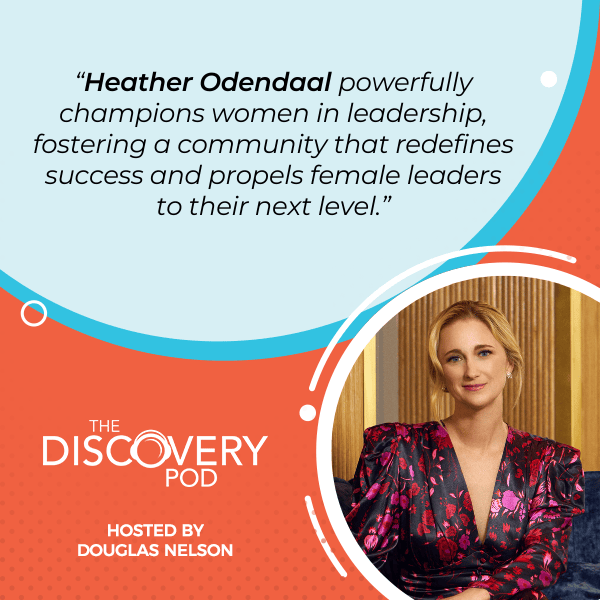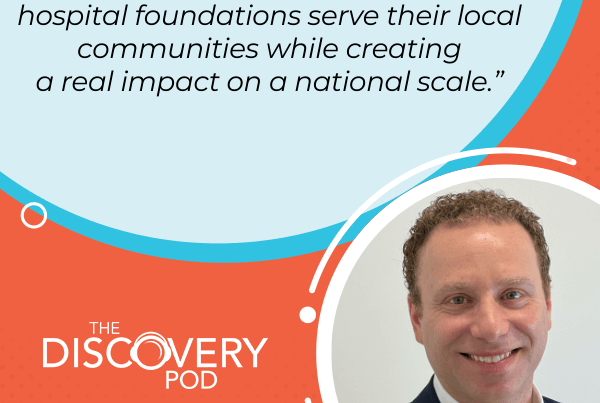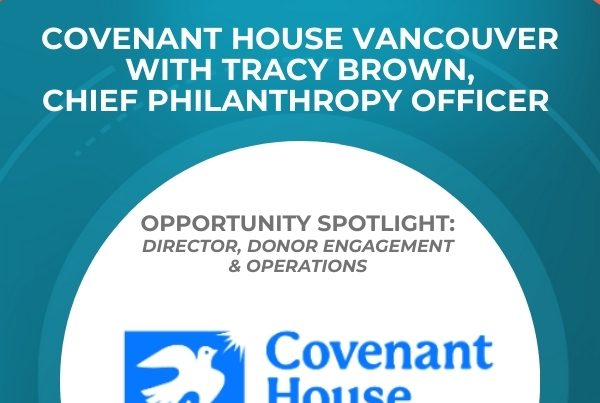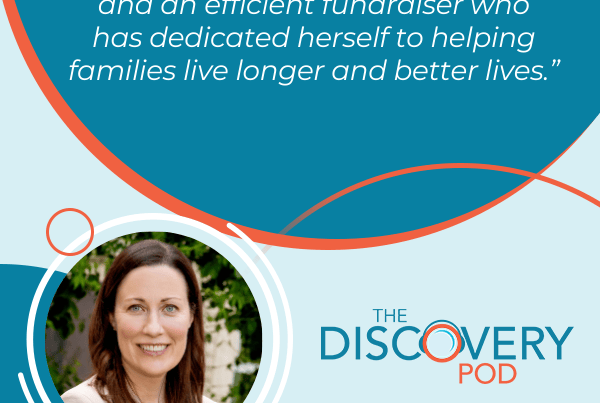
Women in leadership are reshaping the future of work, and Heather Odendaal, founder and CEO of WNORTH, is at the forefront of this movement. What began as a single conference in 2015 has grown into a powerful national platform connecting and advancing women leaders across sectors. Heather shares the inspiration behind WNORTH, insights on the shift from corporate to purpose-driven and social profit roles, and why women are increasingly influential in philanthropy and leadership. She also underscores the importance of storytelling, quality over quantity in building meaningful conversations, and the role of peer support in mid-career growth. Plus, Heather offers a glimpse into North of Now, her upcoming international event with Virgin Unite, designed to spotlight new leadership styles and social impact.
—
Listen to the podcast here
Women Redefining Leadership Success With Heather Odendaal, Founder & CEO, WNORTH
In honor of Women’s History Month, we’re spotlighting women advancing leadership and equity across sectors. Our guest is Heather Odendaal, founder and CEO of WNORTH, a community she built to help women redefine success and support each other’s growth. What started as an annual conference has grown into a national platform, connecting female leaders through events, workshops, and online resources.
Recognized as one of Canada’s top event professionals and a global male top 50 change maker, Heather continues to champion women’s leadership and opportunity. In this episode, she talks about what she’s learned over ten years of the WNORTH Conferences, the increasing desire for women in the for-profit world to hear from leaders in the social profit sector on what makes their purpose-driven work so important and so effective. It is a great conversation about the development of leadership, the conversations that people have about leadership, and the growing force of women leading in our social profit sector.
—
Welcome to The Discovery Pod, Heather.
Thank you for having me, Douglas.
Heather, it has been a long way to get you on. Very busy person in demand. Really excited for the conversation we’re going to have and really looking forward to sharing it with our listeners. WNORTH, a conference in Whistler, is a part of a much larger branded story that you tell of gatherings that you put together in the course of a year. Tell us a little bit about WNORTH and how it got started.
The Origin Story: Heather Odendaal’s Inspiration for WNORTH
WNORTH is a global membership network of leading women who are redefining success. We really focus on elevating women in the leadership pipeline. These are women in senior manager and director-level positions who have ambitions to get to their next level of leadership. A growing number of our women are also scaling entrepreneurs who were one day a solopreneur and woke up the next day running companies. A lot of the ethos behind what we do is leveling up your leadership and connecting with like-minded senior women. That’s what I do.
How did you come to put this together? This is really an important need, and you’ve been doing it for ten years. What was the start? What was it like, your moment where there had to be a better way?
I was working in a mid-management position at a Fortune 500 company. I was actually a remote employee, which we all know more than ten years ago was somewhat of a rarity, not as much as it is now. I was looking to move into that next level of leadership, and I look to my organization for more advanced leadership development training, for maybe a budget to do some coaching, a conference to attend, and just to level up that leadership, from a women’s lens.
My organization did not, at the time, have any tools or programs that were specifically for my level of leadership. You had to be much more senior in the organization to access some of those resources. Of course, being a remote employee, there were some courses or training, but they were all held in a head office that I wasn’t able to get to. I went looking initially for a conference that brought together women from across North America to really high-level networking, leadership development, and an all-encompassing experience altogether. There were two things that I had my eye on in the US that prevented me from going there. One, it was over $10,000 to attend.
The second was, there was an application process, and my application was rejected. It made me think that there’s got to be a better way. There’s got to be something that is out there supporting specifically corporate women. I was half in the space of entrepreneurship. I had started my events company a few years prior on the side, and I had seen a lot of stuff in support of entrepreneurs in the space. There are organizations like YPO and EO supporting entrepreneurs, and I just felt that there was a missing link. In 2015, I hosted the first WNORTH conference in Whistler. As you mentioned, we just celebrated ten years.
A straight line from that first one in 2015 to 2025?
I did share, I’m an event planner and conference planner now. It was a few rocky roads.
It was a couple of years that would have been a little bit tough if I recall
It was a bit tough. I will say I won’t dwell on the corporate event planner during a pandemic story, which is a whole other podcast. What I will say is, this year, celebrating ten years was a huge milestone for us because I’ve really felt like we had a number of these hiccups that put us back ten steps, but we managed to get through them all.
One of the things in entrepreneurship that seems to be celebrated a lot is when you launch something, and sometimes they’re not really celebrated for keeping things going. It’s fairly easy to launch a company these days, I have to say. The websites, the AI, the technology, but it is keeping the lights on and keeping the growth trajectory and battling the storms, whether it be an economic recession or a pandemic. That was a really big prime moment for me, celebrating that this year.

Women In Leadership: One of the things in entrepreneurship that seems to be celebrated a lot is when you launch something. Sometimes, they’re not really celebrated for keeping things going.
One of the reasons I was really excited to have you on the show was because a number of our guests, we’re going to really close to 300 episodes of The Discovery Pod now. Many of our guests have been women in that position of leadership or stepping into that position of leadership. You didn’t mention, you artfully avoided the the mentioning the pandemic, but one of the things that we’ve seen through our work at The Discovery Group and we’ve certainly talked a lot about on the podcast is one of the benefits or one of the positive outcomes of the pandemic was it really accelerated the pace of change in leadership in the social profit sector.
There were many younger, often more culturally diverse, and certainly more female than had been previously the case. CEOs coming into position. We’ve had dozens of folks on the podcast who had their first opportunity to be CEOs. What we’ve seen is that the face of leadership in our social profit sector is changing. I see that very much as a positive that it reflects the workforce of the sector more effectively, and it reflects largely the communities that these organizations are serving, more appropriately. I’m curious, what have you seen change in the conversation about women in leadership positions from that first conference in Whistler in 2015 to celebrating that tenth conference earlier this year?
The Evolving Landscape Of Women’s Leadership
There are a couple of shifts. We’ve seen the roller coaster ride of giving people, not just women, but people, flexibility and work from home options, and then them revoking that ability over the course of ten years. What I have seen in the way that people are leading and the way that people are choosing to lead and which organizations they’re choosing to lead, is that there is always a threat, especially with women, to have that social impact.
We are seeing a record number of women leaving a very corporate workforce. Because of some of these really big pulls to come back to the office, shareholders return the number of people who are the number of our organization members work for larger tech companies. We see they’re now doing the role of 3 or 4 different people. On the social impact and nonprofit leaders, what I’m seeing is I’m seeing a large shift in the way, first of all, there are a lot more people moving into that sector away from corporate.
Obviously, also increasing the quality of leadership that you have to choose from in that nonprofit sector, because those women are looking for purpose. They want more than just a paycheck. I think that’s something we’re really seeing. I’ve also noticed I’ve had to change some of the language at WNORTH in terms of getting to the C-suite. As you mentioned earlier, not everybody wants to be the CEO of a large corporation, and everybody has a different definition of success.
Not everyone wants to be the CEO of a large corporation; everyone has a different definition of success. Share on XI’ve changed some of my language to be now we are, a membership of leading women who are redefining success, because what does that success look to you look like to you? Is that being able to leave your role or your office at 3:00 to be able to pick up your kids? What flexibility that you given? Also, what is the takeaway? What did I do at the end of the day today at work? I think that’s where we see women really thrive is when there is that impact and there is that evidence that what they did today made a difference.
I think there’s, in summary, a growing number of very highly qualified people to choose from, including women. I also think that from what I’ve seen, I paint the whole picture, the nonprofit, structure, and hours, and the way that a lot of them operate is just a much more friendly environment for women with a number of external pulls, whether that be children, whether that be the need to work from home. Those are some of the shifts I’m seeing specifically in that industry.
It’s really remarkable. One of my pet peeves about the social profit sector in general is that it’s so much anchored in scarcity that we don’t have enough, and we make do, and we do the best we can with a little bit, a little bit that we have, and we do more than people expect of us. That’s how we pat ourselves on the back. One of the shifts that I’ve seen is really the increasing sophistication of leadership in the sector. Not just in the C-suite but across the sector. To understand that success for the organization and for the professionals in it is something more than just getting by, and that seeking meaning in the charitable sector.
One of the jokes that we often talk about is, “We’re nice for a living. That’s our job.” That really only gets you so far. That gets you invited to cocktail parties. It may not get you invited to dinner. That rising tide of professionalism that I’ve seen around leadership tables of the sector in general over the last number of years is really encouraging. From your conference attendees and the conversations that are happening in your forums, what are you seeing happen for leaders who have made that switch from for-profit to the social profit sector? What are they finding?
Finding Fulfillment: Corporate To Social Profit Sector
I think in general, a greater fulfillment. There’s definitely a longer staying power. There are a number of our members that left corporate roles during the pandemic, took a bit of a break, and then for a number of reasons, and then I’ve reentered the workforce in the nonprofit space. From speaking to those numbers, I would say there’s definitely longevity. They see a future with the organization. They see their impact, obviously.
There are challenges as well. Depending on which type of organization, the pace is different. That definitely is something to get used to, whether it’s that some are faster-paced non-profit, some are much slower-paced and very big organizations with lots of things and structures to learn. In general, from those I’ve spoken with, the feedback has been very positive.
Also, I want to know from a programming perspective, there’s a lot more interest from corporate leaders to hear from nonprofit leaders. I’ve noticed a shift in our stage as well in terms of the types of organizations and types of leaders we’re putting on stage and the stories that they want to hear.

Women In Leadership: From a programming perspective, there’s been a lot more interest from corporate leaders to hear from non-profit leaders.
There are a lot of people, if they’re not in the nonprofit space, who attend our conference and our events. They are sitting on boards, and they are in positions where they influence the organizations that they’re working with. I think there’s a huge opportunity for that thought leadership in the same way that CEOs of large organizations are taking a stand and being more vocal on LinkedIn and being a bit of the face of the organization. I’m seeing that big shift as well in terms of seeing nonprofit leaders also being able to shape that narrative.
I agree with that entirely. I’m curious. You are a world-class convener of conversations around topics that matter. You’re bringing people to the table, but I assume every day or nearly every day, or planning on how to bring people together every day. How do you measure a successful day? What does a successful day look like for you?
It is so interesting because I’ll take you back to our ten-year anniversary conference that we just had in Whistler in early May. 2024, so last year’s conference was a bang year. It was so good. There was so much positive feedback. Everybody said 10 out of 10. Going into this year, celebrating a milestone, changing venues, I was very overwhelmed and intimidated by how this was going to go because we had had a very successful year. I started to think about what you just asked in terms of how I measure success. There were a couple of things that I would say factor in.
One is that I’m not satisfied if it’s just the content that’s good. There have to be connections, and the moments that are outside of the conference room that are made. In addition to having content that on stage that resonates with everybody, that is delivered concisely, that’s actually one of my biggest things as I do twenty-five-minute panels a lot of the time, because I don’t believe that we need to be going on for 45 minutes to an hour for some of these things.
Concise but impactful content, these true connections that are made. What I’ve learned over the years is that these connections need to be nurtured. That was why in 2018, I started a membership model to continue to build these connections and these conversations because I had hosted the conference three years in a row. It’s great when you walk into a room and you have a great time, and then you walk away. What is the impact that you’re going to have?
When are you going to see those people again? We’ve all walked away from a conference being like that. That was great. Now I have to just walk back into my everyday life, and will I do things differently? Maybe a little. I think for me, it’s always been about building trust over time with people, creating those moments of connection, and then re-inforcing those connections so that you walk into your next event and you see familiar faces. Those are some of the ways I measure success is through, not just short-term impact but long-term as well.
Crafting Connection: The Art Of Impactful Convening
That idea of creating connections and convening and bringing people together for a purpose, that’s something that a lot of organizations in our social profit sector spend a lot of their time thinking about, how to bring people together, how to do that. Do you when this is this is your career? Please summarize it in thirty seconds or less. What are the key elements when leaders want to bring together or play that convening role for purpose and for the long term?
One of the ways I’ve built this brand, which I would say is that it’s not the quick road to success, but it is from the focus on really great storytelling. The challenge with that model, like, on a fiscally responsible, is I don’t gravitate to somebody’s a speaker just because they are the head of AI at the largest tech company in the world, as an example, because they may not be a great speaker, and they may not have a great story to tell.
I actually attend a lot of conferences myself. I listen to a lot of speakers. I watch a lot of TED Talks. I would say it’s not that you need a lot of speakers, you just need the right ones. We’ve got three days of programming, and we usually have under 30 speakers, which is even a lot now, I feel like. You go to some of these conferences, and there are hundreds and hundreds of speakers and depending on the size. I just think that you need to focus on quality versus quantity, lose the job title.
It's not that you need a lot of speakers. You just need the right ones. Share on XHas this person spoken before? What stories do they have to tell? Those are just a couple of the things that guide me. I will preface this by saying that sometimes, from a marketing perspective, you’re bringing together a group depending on the topic that seemingly you don’t think it’s going to go together. That’s the magic behind knowing the stories that these people are going to tell, having a prep call to prepare them, and making sure that they have a jive, so to speak, with the other panelists.
You mentioned earlier that you’re getting demand for people wanting to hear from social profit leaders more and more at these conferences. What is it about the messages that social profit leaders have to bring to their fellow attendees that people are hungry for?
I think even just more recently in the last six months, we’ve seen a huge shift of a focus inward in Canada with regards to where we are donating our dollars, where we are spending our money, where we are spending our resources, and how we are protecting our resources in Canada. I think that is only going to elevate even more over the next few years. With our demographic for WNORTH, we obviously have nonprofit leaders.
We also have corporate leaders. We also have a lot of women who are in later stages in their careers, and so they have money to give. They have money to invest. As we know, a lot of women lead some of those major investments on the family side. I think it’s a curiosity. I think it’s an educational piece. I think it also depends on where you’re at in your career, which we tend to have a little bit more senior-level leaders. I think it’s a curiosity and an actual interest in wanting to make a change.
One of the things we’ve seen a lot of in the charitable sector and the fundraising world is that more and more women are the decision makers as it relates to family philanthropy. Historically, it’s been dad making those choices often or and then mom and dad in some cases. More and more, it is the female spouse or female head of the family who is leading and making those philanthropic investment decisions.
It’s had a really interesting effect on the conversations that a lot of organizations are having with their donors because it is a different type of motivation. The essential purpose remains the same for the organization. How you talk about impact, how you talk about the difference a donation makes, has really shifted quite a bit in the last decade. I wonder if that’s a trailing indicator of that change in leadership that you were describing earlier.
I think so. I think that there’s an enormous shift that has already started to happen with regards to, you probably know this, but the inheritance and passing down of wealth from one generation to the next. I believe the statistics are that three-quarters of that is going to women. There is a huge opportunity, and there is also a lot of interest for women to be more involved and to get more involved in how these investments are made. I sit on the organizing committee, and I’m the event producer and co-chair of a new gala for the Whistler Community Foundation.

Women In Leadership: There is a huge opportunity, and a lot of interest, for women to be more involved in how these investments are made.
Just myself really diving into these ideas of endowments and how we’re building. We’re in the process of trying to grow the endowment from 9,000,000 to 25,000,000 in the next few years. It’s no easy mission. What we do see opportunity through is building our relationships with the local community and the donors of many of whom I meet with are women. I definitely think there is a correlation, and it’s an opportunity, I think, for the nonprofit sector to really nurture the relationships with some of their biggest donors.
Navigating Career Growth: Advice For Mid-Career Women
It’s been fascinating since I started my first fundraising job was in 1999, and I remember going to a conference very early in the February, 2000, 2001, 2002, and David Foote was still touring his book, Boom, Bust & Echo about this, demographic shift that was coming in this tsunami of philanthropy that was going to come as the boomers pass it on down to their children as the civics and the boomers pass it on. My entire career, people have been talking about this wealth transfer.
Realizing in the last few years, “It’s really happening. In fact, it may have already crested, and now it’s fascinating to see the change that that’s had.” I would just echo the decision makers in so many of those gifts is often the surviving spouse, which seems almost always is the wife, and she’s going to make the ultimate philanthropic decisions. As I said, it’s changing the way organizations are talking to their donors, I think in a healthy and respectful way, but it is different.
Yep, 100%.
As we were getting started, I mentioned that a number of the people that tuning in, and we think we guess, that it’s more than half of the folks that tuning in other than my mom, are people who are seeking leadership positions or wanting to probably working in the social profit sector, or on boards and wanting to learn more about the sector, but people wanting to take that next step up in their career in the sector. You mentioned you’re an avid TED Talk watcher. You host these incredible conversations at WNORTH and have been around the table for so many of these. What’s the best advice you’ve picked up or that you would share for women in mid-career who are looking for that next level of responsibility in their organization?
Similar to how we diversify our investments, we need to diversify our skill set. I think that I see a lot of young people really setting their sights on a top-level position and not necessarily realizing that there is a lot of what we call the ladder versus lattice approach, which is, in my day, there were a few setbacks. The 2008 recession was one of them, where I took my next role after being a director was an assistant.
Similar to how we diversify our investments, we need to diversify our skillset. Share on XI was a director at a nonprofit, and I took a corporate job as an assistant. I don’t talk about that a lot, but it’s one of those things that it’s pretty normal and for a lot of us growing up to have had these experiences where there was you had one opportunity in this organization. I think my advice would be that you need to be flexible, especially in this current job market. If there is a lateral move in your organization and additional skill sets that will better suit you for a top-level position, then take a lateral move.
It’s not always about climbing that ladder straight up. I think it’s this. With all of the challenges with AI, we don’t know what jobs are going to be. We don’t fully understand what jobs are going to be affected, and I’m going through this a little bit with my own children, who are just nine and six. What are some of those roles that are still going to be here in 20 to 30 years?
I think it’s about diversifying your skill set, and then the second thing I would say is find some peers in whether it’s in your organization or another organization, through peer groups at WNORTH, we run forum programs, but just find some peers. I don’t believe it’s all about mentorship these days. I think there is a lot to learn, but I also believe that things are moving so fast that we have a lot to learn from each other. I’d say, “Find some peers that you can bounce ideas off of, and help you with your growth.”
The Power Of Peer Support: Building Your Leadership Network
One of the things that I’ve learned doing this show is asking a number of CEOs and asking female CEOs what they do. What do they do when they have a particularly bad day or they have a really hard issue? There’s a high frequency that the client will share that she has an emergency 911 list of peers that she will call. It’s usually the same 3 or 4 folks, some of them in the sector, some outside of the sector. Just have that written off and and very quick response on that. That connection appears to be really important.
It’s hard to find sometimes for women at the top sometimes because there are so few. I think that was also something I saw when I built WNORTH, and one of the reasons I have a forum program is because I saw forums at YPO and EO, YPO being Young Presidents Organization, and EO being Entrepreneur Organization. They have these high-level forums that executives could bounce ideas off of, and I didn’t see that same opportunity for women. That’s very validating that you say that about some of your guests because it means that we’re serving a purpose to what they need.
Can I share an observation about your answer there? Something I’ve thought a lot about. Often when we’re talking to male CEOs or male leaders in the sector, they say their advice will be, “Focus on what you’re good at. Be really good at what you’re good at.” That’s the key to the ladder. That’s the way you take the ladder, not the lattice up. More often than not, that diversification of skills and doing more and having a broader view and a bigger perspective is often what female guests and female leaders will say. I say that without evaluation. It’s not like one is right or the other, but it is a reality, and it’s not universal, but it is frequently occurring. When you hear that distinction, what comes to your mind?
I always think of the statistic that everybody knows, which is the idea that men will apply for a job if they’ve got 2 of the 10 qualifications, and a woman will only apply if she’s got all 10. I actually had that flashback in my mind when you said that. I guess I say this diversification of skill set, not necessarily from the perspective of you cannot go to the next level.
There’s also just something humbling about going into something that you completely know nothing about, that I think all leaders should do, whether they do or not, I just find the best leaders that I’ve come across is usually maybe it’s the mattress salesperson who’s made their way all the way to the chief revenue officer of the national mattress chain or whatever.
They could go into a number of different sides of the business, learn different sides of the business, and advance that way. It’s not the only way, but I think it to be truly successful in their role, I think understanding the business from the inside out. Maybe it’s not taking a full role in a department that you don’t know anything about. Maybe it’s a lot of great organizations that have done the role sharing or the job shadowing and that type of thing.
I think it’s about learning multiple sides of the business. I run we run a pretty lean ship here at WNORTH, and I do website edits. I do the back-end funnels in the CRM systems. I’ve had my team grow to almost 10, to down to 2. When we are lean and we have a smaller team, I know how to do everything. Should I be doing everything? No. Probably not, but I know how to do it. I think that type of skill set to me is super valuable in the long run.
As you were sharing that, I was thinking of a conversation I had with a former colleague, somebody that I had worked with, and when I had an enrollment job working in an organization, and she was wanting to move into the CEO position at an organization. She said, “I’ve this is I’ve been primarily focused on human resources, and this is what my expertise is.” Very strategic thinker. Great view of the organization. Really understood the way the gears of the place in a great way and understood the purpose very well. Very compelling communicator. She says, “I think I should take a job in fundraising for a couple of years so that I have that.” I said, “Why don’t you just start applying to be a CEO?”
True.
This is someone who is very much ready to take that step and to move into that. It is that she didn’t have all ten qualifications to check in. She wanted to fill in a few more boxes before she felt comfortable. Again, the leadership change that’s happening in the sector, there are more roles than people who are traditionally qualified.
They can check 8 of the 10. Most organizations are choosing people who can check 4 of the 4 to 6, regardless of whether it’s male or female. There is more room for creative leadership choices that organizations are making. I think it’s great for the sector because we don’t need the same leadership style that we’ve had. If everybody has the same qualifications, it’s hard to see where the innovation is going to come from. I hope people take the jump and apply, maybe not 2, but 4 or 5. That’s enough.
I love what you said about innovation. I do think that this is a time of disruption, and I think in any sector, if you’re not being innovative, you’re going to be left behind. I think it’s about attracting new innovative leaders to the sector as well, to make sure that everything stays on track.
This is a time of disruption, and if you're not innovative, you're going to be left behind. Share on XNorth Of Now: WNORTH’s Global Vision
Heather, I have so much respect for what you’ve done and what you’ve built, and the fact that you have recovered from whatever trauma happened in 2020. April will. I think what you’re doing is really important, and bringing people together, bringing women together, around this concept of redefining leadership is important for society. I think it’s critically important for our social profit sector. I know you’ve got something really big coming up in December, a little bit out of our borders, but I wanted to give you the chance to talk a little bit about what you’ve got going on in London.
For sure. We are presenting an event called North of Now, and it’s in partnership with Virgin Unite, which is the nonprofit that is supported by Virgin Group. This is a fairly large international event for us, and we’ll be hosted at the Virgin offices, which is a direction. We’ve just seen a huge shift in the last couple of conferences that we’ve produced, with a desire and a need to talk about being a leader, but an impactful leader.
This one specifically will be talking about some of the shifts in leadership styles, a new face of leadership from a social impact lens. We have some really big-name speakers, which I haven’t shared yet, but it’ll be Wednesday, December 10th, 2025, in London, England. We’re just really excited. I’m also planning a leadership delegation of Canadian leaders, and I will be able to share more of that in September. Hopefully, if you’re tuning in and this sounds interesting to you, I encourage you to reach out.
That’s great. It’ll be up on your website as this episode goes to air. Everybody, you should check that out, and check out the WNORTH website, which will be in the show notes, as well. As you come to the end of our conversation, Heather, what are you looking forward to?
It’s a great question. As I’m just in the middle of my summer, where I had lots of holidays. I feel like it’s a fresh start. I love September and this time of year. It’s the school year and the beginning of the school year. For me, it’s the next era of WNORTH. We had our ten years last year, just finished up, and I’m looking forward to building the next ten years and creating impact. Not one thing specifically, but it almost feels like a fresh start. It feels like we can go anywhere, do anything, and change if we want, because we’re in that next era.
That’s great. Heather, thank you so much for the work that you do and the work of your team there at WNORTH. Again, really important, great conversations with some resounding impact throughout our social profit sector. Thank you for being on the show.
Thank you so much for having me, Douglas. I appreciate it.




